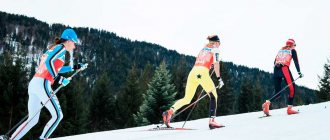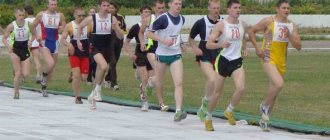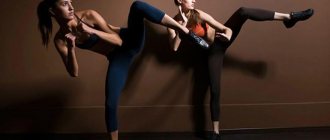The snatch and clean and jerk are classic exercises performed in weightlifting competitions. They require not only physical strength, but also a high level of coordination. When working with heavy weights, a clear understanding of the physics of movements and practicing the correct technique becomes the main component of success.
Both the barbell snatch and the clean and jerk are complex multi-component exercises. Each phase of the barbell movement during their execution has its own name. This is done for convenience and a better understanding of the physics of movement. Let's look at these phases further.
Snatch and Jerk Phases
The snatch and clean for the subsequent push (not the push itself) have a similar execution technique. Therefore, they can be considered together. These two elements include the following phases:
- Start is the starting position of the athlete from which he begins the movement.
- Traction - lifting the projectile off the floor and raising it to above the knees.
- Detonation - giving a projectile a sharp upward acceleration.
- Squatting (walking away) - “diving” under the barbell and fixing it on outstretched arms (or on the chest for a push).
- Squat raise - the athlete rises with a barbell.
- Fixation is the end of the movement.
If the barbell is taken to the chest and then it is necessary to perform a push, then the movement continues in the following phases:
- Half squat is a small squat.
- Ejection is a sharp upward push of the projectile.
- Squatting - going under the barbell.
- The squat raise is the final lift with the barbell at outstretched arms.
- Fixation is the end of the movement.
What weights are used?
Today, three weight categories of projectile are widely used - 16, 24 and 32 kg. The snatch with the smallest weight is used by athletes when passing the GTO standards. The task is to lift the projectile as much as possible within 4 minutes. Not everyone manages to meet the established standards, since they require quite serious physical training. For example, men under the age of 40 must snatch a weight of 16 kg at least 40 times to be able to receive a gold GTO badge.
Beginners are advised to use a weight of no more than 32 kg. For girls, lifting even such a weight of weights may be unbearable, so they are recommended to use special women's equipment weighing up to 10 kg.
Before approaching training with kettlebells, it is recommended to go through a preparatory period, including deadlifts and push-ups using the military press technique in the program.
Interesting: How to strengthen your arms by training against a wall?
You should always aim for the same number of repetitions with both hands. If one hand turns out to be weaker than the other, then classes should begin with it. To train strength and endurance, it is recommended to include exercises in the program for 10 minutes, during which the maximum number of repetitions should be performed.
Jerk
This is the first exercise performed in a weightlifting or powerlifting competition. Next, the jerk technique will be considered, including the features of performing each of its phases.
Snatch exercise.
Start
In the starting position, the athlete stands in front of the apparatus so that his shoulders are strictly above the bar, and his toes are under it. The feet are shoulder-width apart, the pelvis is laid back, there is a natural arch in the lower back, and the gaze is directed forward. Slight differences in starting position are allowed depending on the height and body proportions of the athlete.
The barbell is grasped with a lock grip. The legs, body, arms and apparatus must form a single rigid frame.
Traction
The bar lifts off the floor due to the powerful force of the legs and back and rises above the level of the knees. The bar moves along the legs not vertically, but slightly towards itself. The arms and back are absolutely straight in this phase of the movement. Lifting the bar from the platform occurs calmly, then the speed of the projectile increases sharply.
Detonation
This is the moment of accelerating the projectile due to the full extension of the legs and straightening of the body, reaching out onto the toes. The effort must be sharp and powerful. Arms are still straight. During the lift, the athlete tilts his torso back and raises his shoulders.
Podsed (care)
Thanks to the acceleration applied at the detonation stage, the bar, as they say, flies up. In this phase, the athlete must quickly get under it. When the bar has lost acceleration and is already moving downwards, it is much more difficult to accept it.
During this phase of the movement, the back remains arched and the pelvis is laid back. Hands actively interact with the projectile. The athlete takes the barbell with outstretched arms (when performing a snatch) or on the chest (if a push is planned next).
The athlete’s legs can be in different positions:
- Low squat (legged), hips pressed to the stomach.
- Scissors, one leg in front, one leg behind, as in a deep lunge.
Correct and quick squatting creates an optimal “base” for subsequent lifting.
Squat rise
Immediately from the squat, due to the powerful force of the leg muscles, the athlete rises to a vertical position. The pelvis moves along a trajectory from bottom to top and slightly back, the back remains arched.
Fixation
The athlete takes the final position, clearly fixing the apparatus on outstretched arms (in the case of a jerk) or on the chest (if a push is then performed).
Powerlifting style bicep curls
Yes, there is such a competition as biceps curls. In fact, it was once even part of the powerlifting program. But guess what? This was 50 years ago, or even more. Today—sorry—no one cares about your personal records in arm curls. And if someone does, don’t listen to them.
Of course, you can find a lot of photos of athletes lifting huge barbells, but heavy repetitions for “one” or “two” are only good for photo shoots, there is no real benefit from them.
Make good pumping your top priority, perform at least 8-10 reps, and your efforts will definitely be rewarded!
Push
This exercise is performed second in a weightlifting competition. To perform a push, the athlete rises after squatting and fixes the position. In this case, the body should be strictly vertical, maintaining a deflection in the lower back, the feet should be spaced wider than the shoulders, the position should be as stable as possible. The elbows are brought forward, and the pelvis is moved back slightly. The bar of the bar lies on the chest, the head is slightly abducted, the gaze is directed slightly above the horizontal.
Push exercise.
Half-squat
The athlete squats shallowly, moving the pelvis back, but maintaining a vertical body position. The movement should not be performed too quickly, as in this case the bar will come off the chest and a powerful push will not work. It is necessary to use the elastic properties of the projectile. A deep squat in this phase of the exercise will also significantly complicate the subsequent push-out, so there is no need to bend your knees too much.
Pushing
Immediately from a half-squat position, the athlete, with a sharp and powerful movement, pushes the projectile vertically upward. The phase ends with almost full extension of the legs, stepping onto the toes and raising the shoulders. The bar is given a sharp acceleration, as in the case of the “undermining” discussed earlier.
Podsed
As the bar moves upward, the athlete quickly moves underneath it, extending his arms and accepting the barbell to complete the movement. Just as in the case of the snatch, the position of the legs in the squat can be either “spread” or “scissors”.
Squat rise
Exit to vertical position. The barbell is held behind the head with outstretched arms, the body is straight, there is a deflection in the lower back, the pelvis is slightly laid back. The gaze is directed horizontally.
Fixation
The athlete completes the exercise.
Standards for squatting without equipment
Unfortunately, the federal budget of our country is not enough to promote the development of powerlifting, so we have only one federation officially accredited by the State Sports Committee of the Russian Federation - the Russian Powerlifting Federation (RFP).
The standard is assigned based on the sum of three movements (squats, bench press, deadlift). There is no separate test for squats. If you want to truly test your strength, I highly recommend taking part in competitions. Competitions are regularly held throughout the Russian Federation; the competition calendar and regulations can be found on the official website of the federation.
There are also more than ten non-state federations operating on a commercial basis. The main funding comes from private investors, advertising of thematic products (sports nutrition, clothing and equipment) and entry fees from competition participants. The most popular non-state federation is WPC/AWPC (without doping control/with doping control). Below are their raw powerlifting standards for 2022.
AWPC-Russia category standards for bare powerlifting for men:
| Weight category | Elite | MSMK | MS | KMS | I category | II category | III category | I junior | II junior |
| 52 | 490 | 432.5 | 377.5 | 340 | 302.5 | 265 | 227.5 | 187.5 | 150 |
| 56 | 532.5 | 470 | 410 | 367.5 | 327.5 | 287.5 | 245 | 205 | 162,5 |
| 60 | 570 | 505 | 440 | 395 | 350 | 307.5 | 262.5 | 220 | 175 |
| 67,5 | 635 | 562.5 | 490 | 440 | 392.5 | 342.5 | 292.5 | 245 | 195 |
| 75 | 692.5 | 612.5 | 532.5 | 480 | 425 | 372.5 | 320 | 265 | 212,5 |
| 82,5 | 737.5 | 652.5 | 567.5 | 510 | 455 | 397.5 | 340 | 285 | 227,5 |
| 90 | 777.5 | 687.5 | 597.5 | 537.5 | 477.5 | 417.5 | 357.5 | 297.5 | 240 |
| 100 | 817.5 | 725 | 630 | 567.5 | 502.5 | 440 | 377.5 | 315 | 252.5 |
| 110 | 852.5 | 752.5 | 655 | 590 | 525 | 457.5 | 392.5 | 327.5 | 262.5 |
| 125 | 890 | 787.5 | 685 | 617.5 | 547.5 | 480 | 410 | 342.5 | 275 |
| 140 | 920 | 812.5 | 707.5 | 635 | 565 | 495 | 425 | 352.5 | 282.5 |
| 140+ | 940 | 832.5 | 725 | 652.5 | 580 | 507.5 | 435 | 362.5 | 290 |
For women:
| Weight category | Elite | MSMK | MS | KMS | I category | II category | III category | I junior | II junior |
| 44 | 287.5 | 255 | 222.5 | 200 | 177.5 | 155 | 132.5 | 110 | 90 |
| 48 | 317.5 | 282.5 | 245 | 220 | 195 | 172.5 | 147.5 | 122.5 | 97,5 |
| 52 | 345 | 305 | 265 | 240 | 212.5 | 185 | 160 | 132.5 | 107,5 |
| 56 | 372.5 | 327.5 | 285 | 257.5 | 227.5 | 200 | 172.5 | 142.5 | 115 |
| 60 | 395 | 350 | 302.5 | 272.5 | 242.5 | 212.5 | 182.5 | 152.5 | 122.5 |
| 67,5 | 432.5 | 382.5 | 332.5 | 300 | 265 | 232.5 | 200 | 165 | 132.5 |
| 75 | 462.5 | 410 | 355 | 320 | 285 | 250 | 212.5 | 177.5 | 142.5 |
| 82,5 | 487.5 | 432.5 | 375 | 337.5 | 300 | 262.5 | 225 | 187.5 | 150 |
| 90 | 507.5 | 450 | 390 | 352.5 | 312.5 | 272.5 | 235 | 195 | 157,5 |
| 90+ | 520 | 460 | 400 | 360 | 320 | 280 | 240 | 200 | 160 |
Working muscles
In conclusion, we can say that weightlifting is called such for a reason. The fact is that both the snatch and the clean and jerk require excellent physical fitness, developed muscles and good coordination skills. When performing these compound exercises, the whole body works, and the muscles of the back, legs, arms and shoulders receive the greatest load.
Beginner athletes should refrain from performing these competitive exercises. First of all, you should start mastering deadlifts, bench presses and squats.
Variations of various strength exercises are used in CrossFit. In particular, an exercise such as a hanging snatch, etc. The weight used in this case, of course, is less than in weightlifting.
Breathing while training with a kettlebell
Since exercises using weights lead to a lack of oxygen in the body, it is necessary to pay attention to proper breathing during training. In kettlebell lifting, inhalation occurs when force is applied, and exhalation occurs when the muscles are relaxed.
To maintain your breathing rhythm, you need to remember three points:
- inhale when lifting the weights and exhale when the athlete makes a lift;
- inhale when squatting and exhale when the trainee straightens his arms and body;
- inhale when the projectile is at chest level, exhale until the swing.
Oxygen is necessary, among other things, to prevent muscles from getting tired quickly.
Triceps
But there is no way to do weightlifting without working out this part of the arms. Training must include exercises for their development. Large triceps are not only a hindrance - they will help when lifting the barbell.
To develop them you need to do bench presses. These exercises develop both the shoulders and arms, and the back and legs. In other words, they help improve the supporting force needed to secure the barbell overhead and then hold it. It is the active execution of bench presses with the maximum possible weight that contributes to the appearance of the huge horseshoe-shaped triceps observed in the best athletes.
These exercises must be approached responsibly. All the weight must be squeezed out, and this is not as easy as it may seem. And when it starts to work out really well, you need to add another 10 kilograms. And then another 10. And so systematically. It’s difficult, but just look at the results of professionals who, using a similar technique, have learned to squeeze a weight that is one and a half times their own! And this is not the limit. Russ Knipp, for example, bench pressed twice his own weight.
Weighted push-ups also influence the development of triceps (as well as the back, arms and legs, respectively). It is worth combining them with a bench press, since such push-ups work the triceps differently. We must remember that this muscle is much more complex than the biceps, so it is worth performing different exercises to engage all its parts and achieve the best result.
Rio 2022. Women's boxing
Suddenly? Do you think that female athletes cannot look attractive in such martial arts? In the ring, dressed in oversized shorts, they are unlikely to be able to show off their shape.
And there is something to brag about.
- Boxing perfectly works the shoulder line, arms, back, and most importantly the abs.
- Thanks to this, these athletes have a completely feminine figure, especially those who compete in a small weight category.
In Rio 2016, our athletes managed to win only one bronze. Anastasia Belyakova became third in the final standings among women in the lightweight, mind you, weight - 60 kg. The graceful blonde has quite feminine curves.
With regular boxing, they promise to lose 2-3 kg in the first month, and this is without dietary restrictions.
Basic mistakes
The main mistake in this exercise is a hunchback, which later leads to injuries. Another mistake is an insufficient angle of inclination, when the athlete holds the body not parallel, but almost perpendicular to the floor. The weights seem to be lifting quite well, but there is no particular progress. Therefore, before you include bent-over rows in your training, you should learn to keep your back straight and strengthen your lower back, not forgetting about it in the future, because the strength of the chain is determined by the strength of the weakest link.
Increasing the number of pull-ups on the horizontal bar Romanian deadlift: secrets of effectiveness











